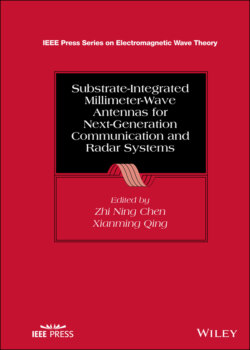Читать книгу Substrate-Integrated Millimeter-Wave Antennas for Next-Generation Communication and Radar Systems - Группа авторов - Страница 27
1.6.2 Commonly Used Transmission Line Systems for Antennas
ОглавлениеLike any antenna systems, their feeding structures will be a critical issue in the implementation of the antenna design. In particular, the losses caused in the feeding networks greatly degrade the performance of the antenna arrays at mmW bands. Unlike the antennas at microwave bands, the losses can be caused by not only the dielectric substrate but also metals used as conductors for transmission and radiation. Like any dielectric at microwave bands, the loss of a dielectric substrate is measured by its loss tangent. Different from the designs at microwave bands, the metal loss that may be caused by the conductivity and surface roughness of the conductors can't be ignored.
Figure 1.5 Simplified descriptions of PCB and LTCC processes. (a) PCB and (b) LTCC.
Besides microstrip transmission lines, the waveguide‐type transmission line systems are popularly used because they may enjoy the lower losses caused by dielectric and metals at mmW bands [23–27, 31]. Accordingly, for instance, the loss analyses have been conducted for microstrip lines, solid‐metal‐wall waveguides, and post‐wall or laminated waveguide or SIW [32]. The study shows that in general the solid‐metal‐wall waveguides without dielectric loss enjoy less metal loss while microstrip lines suffer from several dielectric losses. The post‐wall waveguides or SIWs feature acceptable total losses caused by both dielectric and metal losses at mmW bands. However, it should be noted that the causes of losses of transmission line systems can be complicated because they will be determined by the materials such as dielectric and metals as well as the types or configurations of transmission lines.
The transmission line systems can be in the form of microstrip lines and coaxial lines. Compared with conventional cylindrical versions, the substrate integrated coaxial line (SICL) is a type of planar rectangular coaxial lines. The lines comprise a strip sandwiched between two grounded dielectric layers and laterally shielded by the arrays of metallized vias [33]. Similar to the conventional coaxial line, the propagation of SICL is still in the dominant mode of transverse electromagnetic (TEM).
The SICLs can be realized using a traditional multilayer PCB or LTCC process. Therefore, SICLs feature the combined advantages of the coaxial lines and the planar transmission lines, including the wideband unimodal operation, low cost, non‐dispersive performance, good electromagnetic compatibility, and easy integration with other planar circuits. It has been used for high‐speed data transmission [34] and various other applications such as antennas, couplers, baluns, and filters at mmW bands [35–41].
Moreover, the substrate integrated gap waveguide (SIGW) or printed ridge gap waveguide (PRGW) is proposed for the transmission line systems at mmW bands. The SIGW or PRGW is the combination of the microstrip‐line and gap‐waveguide technology based on the PCB or LTCC process [42–44]. The invertedprinted strip line is arranged on or above the periodic mushroom structures where the unwanted surface waves are suppressed and only the quasi‐TEM mode is permitted over the operating band. Unlike SIW or SICL, the top and bottom grounds of a SIGW are unconnected. Therefore, the processing complexity is greatly reduced. The SIGW/PRGW technology has been widely used in the antennas and arrays at mmW bands [44–51].
It should be noted that the selection of the materials and transmission line systems significantly affects the antenna efficiency. The loss analyses of antennas including their feeding structures are strongly suggested to understand the main causes of the losses in order to control the overall loss by properly selecting the materials and the types of transmission systems, as well as optimizing the design configurations [52].
